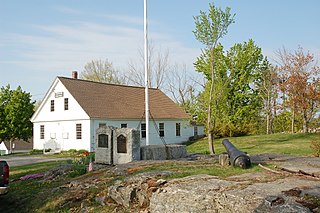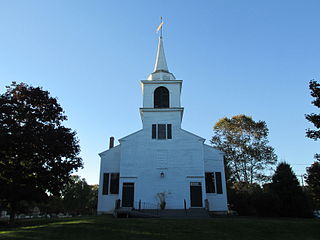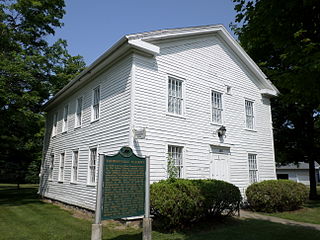
Pomfret is a town in Windham County, Connecticut, United States. The population was 4,266 in 2020 according to the 2020 United States Census. The land was purchased from Native Americans in 1686 and the town was incorporated in 1713 and named after Pontefract in West Yorkshire, England.

The Lyndeborough Center Historic District, located in the town of Lyndeborough, New Hampshire, United States, consists of three structures: the Town Pound, Town Hall, and Congregational Church. The district was placed on the National Register of Historic Places in 1984. In 2010, by town meeting vote, this district became part of a larger, officially zoned local historic district.

First Unitarian Church is a historic congregation of the Unitarian Universalist Association in Cincinnati, Ohio, United States. Founded in the early nineteenth century, it survived a series of division and reunifications in the nineteenth century. Among the people who have worshipped in its historic church building on the city's northern side are many members of the Taft family, including William Howard Taft, the President of the United States.

All Souls Unitarian Universalist Church, built in 1894 in the Richardsonian Romanesque style is an historic building located at 25 Church Street in Bellville, Ohio. On January 1, 1976, it was added to the National Register of Historic Places.

Atwater Congregational Church is a registered historic building in Atwater, Ohio, United States, listed on the National Register of Historic Places since February 23, 1973. It was built in 1841 and incorporates elements of both the Federal and Greek Revival styles and stands over 100 feet (30 m) tall. The church has had a continuous congregation that was founded in 1818 and continues to meet today as a non-denominational church. The building has undergone several renovations and repairs through the years.

Barrington Civic Center Historic District is a historic district in Barrington, Rhode Island on County Road. The district, which consists of the Barrington Town Hall, Leander R. Peck School and Prince's Hill Cemetery, is located on Prince's Hill near the center of Barrington. In 1728, Prince's Hill Cemetery was purchased and later expanded to its present size by 1898. The 1+1⁄2-story Barrington Town Hall was completed in 1888 and originally served as the seat of the town's government, library and high school. With the completion of the Leander R. Peck School in 1917, the high school moved into the adjacent building and the library used its space. The two-story Elizabethan Revival style Peck School is designed with a T-shaped plan and features a stairway to access the main entrance on the second story. The Peck School was later used by the fifth and sixth-grade elementary students before becoming the public library. Also located within the district is Wood's Pond. The Barrington Civic Center Historic District was added to the National Register of Historic Places in 1976 and serves as a historically significant example of civic and natural environment planning of the late nineteenth century.

Twinsburg is a suburban city in Summit County, Ohio, located about halfway between Akron and Cleveland. The population was 18,795 according to the 2010 census.

The Worcester City Hall and Common, the civic heart of the city, are a historic city hall and town common at 455 Main Street in Worcester, Massachusetts. The city hall and common were added to the National Register of Historic Places in 1978.

First Parish Church in Plymouth is a historic Unitarian Universalist church at the base of Burial Hill on the town square off Leyden Street in Plymouth, Massachusetts. The congregation was founded in 1620 by the Pilgrims in Plymouth. The current building was constructed in 1899.

The First Congregational Church of Buxton, also known locally as the Tory Hill Meetinghouse, is a historic church on ME 112 in Buxton, Maine. Built in 1822, it is an example of Federal period architecture, having had only modest alterations since its construction.
The Holland Congregational Church is a historic church on Gore Road in Holland, Vermont. Built in 1844, it is a prominent local example of Greek Revival architecture, and is the town's only surviving 19th-century public building. It was listed on the National Register of Historic Places in 1986.

The Clarendon Congregational Church is a historic church building at 298 Middle Road in Clarendon, Vermont. Built in 1824 and modified with Gothic features in the 1880s, it is a well-preserved 19th-century brick church. The building was listed on the National Register of Historic Places in 1984. The present minister is Rev. Bill Kingsley.

Pilgrim Congregational Church is a historic congregation of the United Church of Christ in Cleveland, Ohio, United States. Constructed in the 1890s for a congregation founded in the 1850s, it was named a historic site in the 1970s.

First Congregational United Church of Christ is a historic church at 700 Poyntz Avenue in Manhattan, Kansas. It is listed on the National Register of Historic Places as First Congregational Church.

The Vermontville Academy, also known as the First Congregational Chapel, is a building in Vermontville, Michigan, located at 106 North Main Street. It was listed on the National Register of Historic Places in 1972, and is part of the Historic American Buildings Survey. It now serves as the Vermontville Historical Museum.

The Baldwin-Wallace College South Campus Historic District is an area of land on the south end of the Baldwin Wallace University campus. When the district was established, the school was Baldwin-Wallace College. BW is a four-year private, coeducation, liberal arts college in Berea, Ohio, United States. The school was founded in 1845 as Baldwin Institute by Methodists settlers. Eventually the school merged with nearby German Wallace College in 1913 to become Baldwin-Wallace College, which adopted the present name in 2012. Several buildings since its founding have been established on the National Register of Historic Places, establishing this area as the Baldwin-Wallace College South Campus Historic District.

The Old Meigs County Courthouse is a historic former government building in the small community of Chester, Ohio, United States. Erected in the early nineteenth century, the courthouse served multiple purposes for the surrounding community in its early years, but it operated as a courthouse for less than twenty years before being abandoned in favor of another courthouse in another community. Following a restoration in the 1950s, it was designated a historic site in the 1970s along with an adjacent school; the two buildings are operated together as a museum. It is Ohio's oldest extant building constructed as a courthouse.

The Chelsea Commercial Historic District is a historic district located along both sides of Main Street from Orchard to North Street in Chelsea, Michigan; the district also includes the adjacent 100 blocks of Jackson, East Middle, and West Middle Streets, as well as structures on Park, East, and Orchard Streets. It was listed on the National Register of Historic Places in 2011.

The East Andover Village Center Historic District encompasses the historic village center of East Andover, New Hampshire, United States. The 2.2-acre (0.89 ha) district includes a cemetery and three buildings: the Andover Congregational Church, the Highland Lake Grange Hall, and the East Andover Schoolhouse. It is located at the corner of New Hampshire Route 11 and Chase Hill Road. The district is unified by the appearance of the three buildings, and their styling, which is predominantly vernacular 19th century.

The Eldora Downtown Historic District is a nationally recognized historic district located in Eldora, Iowa, United States. It was listed on the National Register of Historic Places in 2009. At the time of its nomination the district consisted of 84 resources, including 65 contributing buildings, one contributing site, three contributing objects and 15 non-contributing buildings. The district takes in the city's central business district, which also includes its governmental, educational, and religious activities. It is located in the original town plat from 1853. Development began around the public square and spread out from there. The present building stock is second generation at the earliest. The oldest extant buildings were built in the 1870s, although the greatest number of buildings were constructed in the 1890s. There were also peak years of construction in the 1910s, and the late 1930s and 1940s. The commercial buildings generally range from one to two stories, but the tallest structure is three stories in height. They are primarily composed of brick construction. Late Victorian and various revival styles from the late 19th and 20th centuries are dominant. The non-commercial buildings include four government buildings, four churches, three residences, a hospital, and a school.























